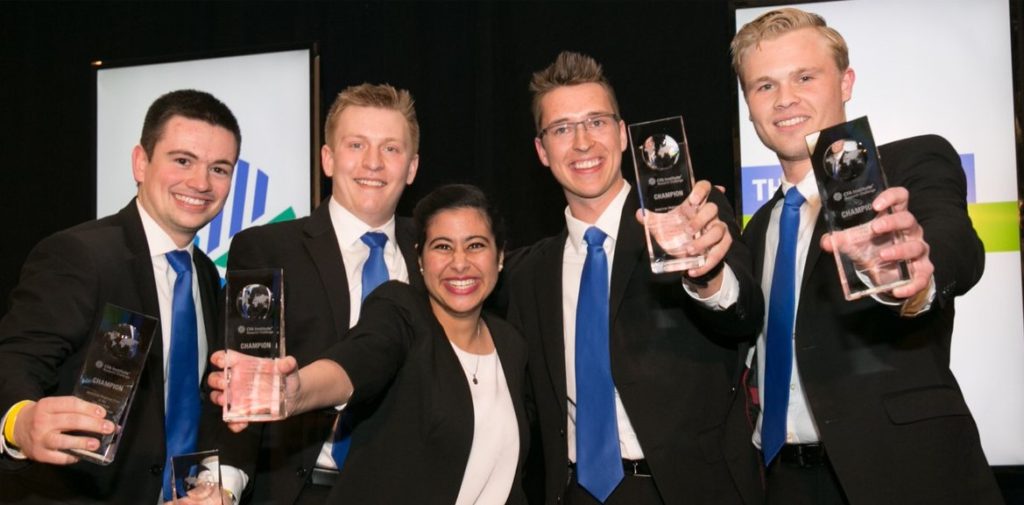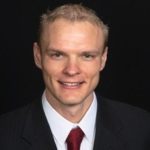 University of Minnesota Duluth seniors Ryan Woitalla, Reed Leonidas, Nawal Mirza, Frank Takkinen and Ryan Kimbrel earned an opportunity of a lifetime last month by winning one of the two sub-regions of the CFA Institute Research Challenge – Americas competition on March 19-20. The team, all members of UMD’s Financial Markets Program, are led by program director Joe Artim.
University of Minnesota Duluth seniors Ryan Woitalla, Reed Leonidas, Nawal Mirza, Frank Takkinen and Ryan Kimbrel earned an opportunity of a lifetime last month by winning one of the two sub-regions of the CFA Institute Research Challenge – Americas competition on March 19-20. The team, all members of UMD’s Financial Markets Program, are led by program director Joe Artim.
After winning the Upper Midwest local competition in Minneapolis in February, the UMD team advanced to the CFA Institute’s version of March Madness, which brought 54 teams and more than 250 students to Boston from countries such as Argentina, Brazil, Chile, Peru, Colombia, Mexico, Barbados, Dominican Republic, and Canada.
The Americas Regional clearly demonstrated to be a very challenging and demanding competition. Every team in Boston advanced out of local competitions collectively besting hundreds of other teams. In speaking with one of the finals judges, it was evident that the margin of victory between teams was very small. Additionally, a 10 minute presentation with 10 minute Q&A certainly leads to a lot of information to communicate and a lot of information for the judges to evaluate. A premium had to be placed favoring those teams that were clear in their recommendation while weaving together facts to support it.
March 20 seemed to be an anxiously long day for the five UMD students who presented their investment recommendation on their subject company Fastenal first in the morning semi-final session before advancing out of the five team pool to the evening finals round. By the time the finals took place that evening, the 54-team field was down to just five for each of the two sub-regions.
On the big stage with the bright lights, the UMD team shined not only in their extensive presentation but perhaps most importantly in the Q&A segment of their “buy” recommendation. My sense was that UMD prevailed not by focusing solely on the 10 minutes of prepared presentation but by spending six months truly grasping a deep knowledge of the company and conducting the proprietary research necessary to excel in the pivotal and unpredictable Q&A.
Faced with advanced questions on the company’s inventory turnover, product mix evolution and future in the face of a growing e-commerce threat, the team seemed to stay in stride. Further, questions on insider trading and short interest could have been easy to overlook or misinterpret.
They now head to Kuala Lumpur, Malaysia for the Global competition on April 27. Just five teams will compete at this level: two from the Americas Regionals, two from the EMEA Regionals, and one from the Asia Pacific Regionals. It will be a couple more weeks of following the tick-by-tick of FAST for the five students who showed the drive, knowledge and teamwork to continue to break new ground for UMD.
 Christopher Young, CFA is a Senior Investment Manager for Wells Fargo Wealth Management and a volunteer for our local Research Challenge competition. He traveled to Boston for last month’s Americas Regional and wrote this first-person account of UMD’s success.
Christopher Young, CFA is a Senior Investment Manager for Wells Fargo Wealth Management and a volunteer for our local Research Challenge competition. He traveled to Boston for last month’s Americas Regional and wrote this first-person account of UMD’s success.





